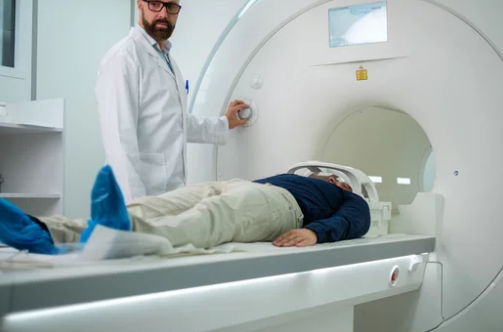Magnetic Resonance Imaging (MRI) has become a cornerstone of modern cancer diagnosis. From detecting tumors to guiding treatment plans and monitoring progression, MRI provides detailed images that other techniques often cannot match. But a common question among patients and even healthcare professionals is: How accurate is MRI in detecting cancer?
In this article, we’ll explore MRI’s accuracy, factors that influence its reliability, and how it compares to other imaging techniques in cancer detection.
Understanding MRI and Its Role in Cancer Detection
MRI uses strong magnetic fields, radio waves, and computer algorithms to create high-resolution images of the body’s internal tissues. Unlike X-rays or CT scans, MRI does not involve ionizing radiation, making it safe for repeated use.
MRI is particularly effective at imaging soft tissues, such as the brain, liver, breast, prostate, and spinal cord. These areas often present challenges for other imaging methods like CT or ultrasound, which makes MRI a critical tool for detecting tumors in complex tissue structures.
Factors That Affect MRI Accuracy
The accuracy of MRI in detecting cancer depends on several variables:
1. Type of Cancer
MRI is highly accurate for soft tissue cancers such as:
- Brain tumors
- Breast cancer
- Prostate cancer
- Liver and pelvic cancers
For cancers in organs with low tissue contrast or high air content, like the lungs, MRI is less sensitive compared to CT scans.
2. Tumor Size and Location
- Larger tumors are generally easier to detect than very small ones.
- Deeply located tumors or those near complex structures may require specialized MRI sequences or contrast agents for accurate visualization.
3. Use of Contrast Agents
Injecting gadolinium-based contrast dye enhances MRI accuracy by highlighting tumors and differentiating them from healthy tissue.
4. MRI Technology and Protocols
Advanced techniques such as multiparametric MRI (mpMRI) or diffusion-weighted imaging (DWI) significantly improve accuracy by providing both anatomical and functional information.
5. Radiologist Expertise
Interpretation of MRI images requires specialized training. Accuracy can vary depending on the experience and expertise of the radiologist.
MRI Accuracy by Cancer Type
- Breast Cancer: MRI is highly sensitive, detecting over 90% of invasive breast cancers, particularly in high-risk women or those with dense breast tissue.
- Prostate Cancer: Multiparametric MRI can detect clinically significant tumors with an accuracy of 80–90%, improving targeted biopsy success.
- Brain Tumors: MRI is considered the gold standard, with very high accuracy in detecting and staging tumors.
- Liver Cancer: MRI is highly effective for small lesions and staging, outperforming CT in soft tissue characterization.
- Lung Cancer: MRI is less accurate than CT for detecting small nodules but useful for staging and detecting metastasis in the chest, brain, and bones.
Sensitivity vs. Specificity
Understanding MRI accuracy involves two key concepts:
- Sensitivity – The ability of MRI to correctly identify cancer when it is present. MRI generally has high sensitivity, meaning it rarely misses tumors in soft tissues.
- Specificity – The ability to correctly identify non-cancerous tissue. While MRI has excellent soft tissue contrast, it may sometimes produce false positives, detecting abnormalities that are not cancer.
High sensitivity makes MRI excellent for screening and detection, but follow-up tests like biopsy are often needed to confirm diagnosis.
MRI vs. Other Imaging Techniques
| Imaging Method | Strengths | Limitations |
|---|---|---|
| MRI | High soft tissue contrast, no radiation, functional imaging possible | Less effective for lungs and bones, longer scan times |
| CT Scan | Excellent for lungs, bones, and quick imaging | Radiation exposure, less soft tissue contrast |
| Ultrasound | Real-time imaging, inexpensive | Operator-dependent, limited in deep tissues |
| PET Scan | Detects metabolic activity, helps stage cancer | Radiation exposure, less anatomical detail |
In many cases, doctors use MRI in combination with CT, PET, or ultrasound to improve overall diagnostic accuracy.
Limitations of MRI Accuracy
While MRI is powerful, its accuracy is not perfect:
- Small tumors in air-filled organs like lungs may be missed
- Motion artifacts (from breathing or movement) can reduce clarity
- False positives can lead to unnecessary biopsies or additional tests
- Cost and accessibility may limit widespread use in some regions
Despite these limitations, MRI remains one of the most reliable imaging tools for detecting, staging, and monitoring cancer in soft tissues.
Tips to Improve MRI Accuracy
- Use contrast agents when appropriate
- Employ advanced imaging techniques (e.g., mpMRI, DWI)
- Ensure scans are interpreted by experienced radiologists
- Combine MRI findings with other imaging tests for comprehensive assessment
Conclusion
MRI is highly accurate in detecting many types of cancer, particularly in soft tissues like the brain, breast, liver, and prostate. Its sensitivity makes it a crucial tool for early detection, staging, and treatment planning. While not perfect, and sometimes requiring complementary imaging or biopsy, MRI provides detailed and reliable insights that can significantly improve patient outcomes.
If your doctor recommends an MRI, it’s because it offers one of the clearest and safest ways to detect cancer, helping guide the best possible care plan.
Also Read :
